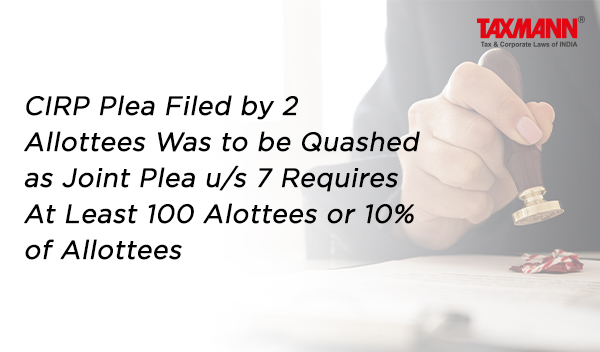CIRP Plea Filed by 2 Allottees Was to be Quashed as Joint Plea u/s 7 Requires At Least 100 Alottees or 10% of Allottees
- Blog|News|Insolvency and Bankruptcy Code|
- 2 Min Read
- By Taxmann
- |
- Last Updated on 25 September, 2023

Case Details: Ms. Rita Malhotra v. Orris Infrastructure (P.) Ltd. - [2023] 154 taxmann.com 471 (NCLT-New Delhi)
Judiciary and Counsel Details
-
- Ramalingam Sudhakar, President & Avinash K. Srivastava, Technical Member
- Rajat Malhotra & Sunil Malhotra, Advs. for the Financial Creditor.
- P. Nagesh, Ranjana Roy, Akshay Sharma & Shikhar Upadhyay, Advs. for the Respondent.
Facts of the Case
In the instant case, the corporate debtor floated a scheme to develop/construct a commercial building/complex at Gurgaon. The applicants under the assured investment return plan submitted applications for allotment of office space/retail units and entered an agreement with the corporate debtor which guaranteed monthly assured return on investment.
Alleging that the corporate debtor breached the terms of the agreement and failed to make a payment towards return on investment, an instant petition under section 7 of the IBC was filed by applicants against the corporate debtor.
However, a settlement was reached between the parties and the instant petition was withdrawn in view of cheques issued for payment till June 2019. Thereafter, an instant petition was revived for a default amount of Rs. 3.6 lakhs.
It was noted that the instant application was filed by only 2 allottees whereas the total number of allottees was 504 and 366 nos of allottees were under the assured return scheme.
The NCLT observed that the applicants did not satisfy the threshold for filing an instant application under section 7 of the IBC. Further, the NCLT observed that since the corporate debtor had already issued demand drafts to the applicants in lieu of full and final payment of assured return and the same was also acknowledged by applicants, an instant application filed by applicants under section 7 for initiating the CIRP against the corporate debtor was to be dismissed.
NCLT Held
The NCLT held that an application for initiation of the CIRP against the corporate debtor shall be filed jointly by not less than one hundred such allottees/creditors in the same class or not less than 10% of the total number of creditors of the same class.
Disclaimer: The content/information published on the website is only for general information of the user and shall not be construed as legal advice. While the Taxmann has exercised reasonable efforts to ensure the veracity of information/content published, Taxmann shall be under no liability in any manner whatsoever for incorrect information, if any.

Taxmann Publications has a dedicated in-house Research & Editorial Team. This team consists of a team of Chartered Accountants, Company Secretaries, and Lawyers. This team works under the guidance and supervision of editor-in-chief Mr Rakesh Bhargava.
The Research and Editorial Team is responsible for developing reliable and accurate content for the readers. The team follows the six-sigma approach to achieve the benchmark of zero error in its publications and research platforms. The team ensures that the following publication guidelines are thoroughly followed while developing the content:
- The statutory material is obtained only from the authorized and reliable sources
- All the latest developments in the judicial and legislative fields are covered
- Prepare the analytical write-ups on current, controversial, and important issues to help the readers to understand the concept and its implications
- Every content published by Taxmann is complete, accurate and lucid
- All evidence-based statements are supported with proper reference to Section, Circular No., Notification No. or citations
- The golden rules of grammar, style and consistency are thoroughly followed
- Font and size that’s easy to read and remain consistent across all imprint and digital publications are applied



 CA | CS | CMA
CA | CS | CMA
